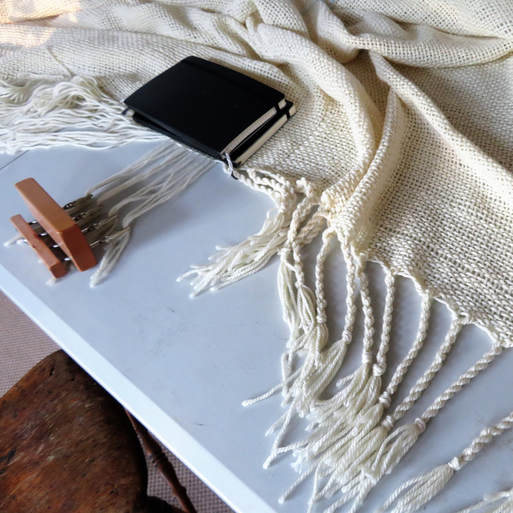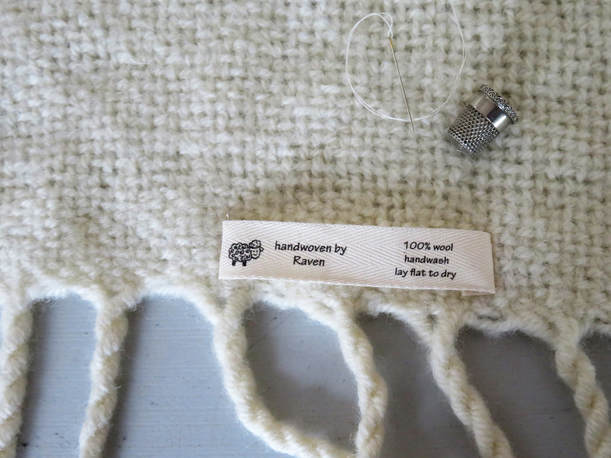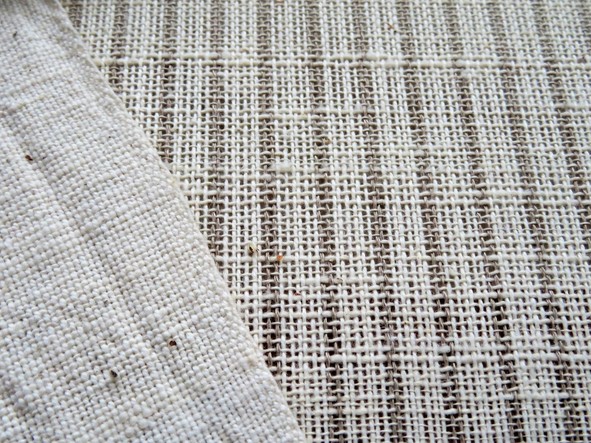|
It's 2 am and there's a pot of Cardamon Coffee steeping on the stove top. I'm going to have to be careful when I drink it. I don't want any stains on this white wool blanket I'm working on. With enough coffee fueled insomnia I have a good chance of finishing the finishing before the day begins. It never ceases to amaze me how much time finishing takes. Making something, be it spinning yarn, weaving cloth, dyeing yarn, or planting the garden is actually the easy part. In most cases, it takes as long to finish a project as it does to make it. Sometimes longer. Linen yarn, for example, is spun at the wheel. That's the easy part. It is next measured into skeins, tied, soaked, boiled in many changes of water, re-skeined and blocked while drying. After which it is inspected again, labeled and stashed away. Same too with this blanket. It took only a few hours to weave, but at least as many to finish. First we cut it off the loom and inspect for mistakes. Next repair the mistakes with a darning needle and yarn. From there, the edges are finished, in this case with a fringe, and after that it is fulled (washed with agitation) to be just right. Finally, tonight's task: the final inspection where I go over every inch (front and back) to locate any loose threads, flaws, areas that need further fulling, or anything else that can be achieved. It's a lot of work, but the results are worth it. Click "read more" on the right to ... And of course, there are the washing instructions to sew onto the cloth. I found these custom cloth labels at the etsy shop mountain street arts. You can see from those two photos how much the cloth has changed when fulled. On the loom the weave was loose; one could easily poke their finger through the web. But after it's finished, the cloth is firm but soft. I'm completely in love with this yarn (Ashford Tekapo 12-ply), even if it is special order in Canada.
Finishing makes stuff better.
Last winter, I had the crazy idea to write a book. The actual writing is surprisingly quick. Like Agatha Christie said, writing is all about thinking up an idea and forcing yourself to sit down and write it down. Finishing the book is so much more complex. Editing, images, covers, formatting, choosing a size, learning how to ship, learning about paper manufacturing so I can make an informed choice on the more eco-friendly options. And now, Homegrown Linen: transforming flaxseed into fibre, is about to enter the next phase. A market test to see if there really are enough people interested in growing their own yarn to justify the existence of this book. Like any project, there's always doubt if things will finish well. That blanket was a whole new experience. Set at four ends per inch, this was the first time I wove with this yarn. I chose a double weave pattern and set to work without making a sample first. It's nerve wracking to put so many hours into something, before we discover if it will finish well.
John
16/9/2019 17:18:05
I'm interested in what ever happened with these guys... did you get silk? Comments are closed.
|
CategoriesAll Airwell Angora Animal Fibre Boring Community Cotton Dryland Farming Dye Etsy Shop Experiments Fibre Prep Finance Flax Frugal Household Management Indigo Linen Local Cloth Mediterranean Climate Natural Dye Permaculture Plant Fibre Sewing Silk Tutorial Urban Fibre Vintage Wildcrafting Archives
February 2022
|
|
Created by Tracy Wandling of One Wing Freelance Graphic Design
|



 RSS Feed
RSS Feed
